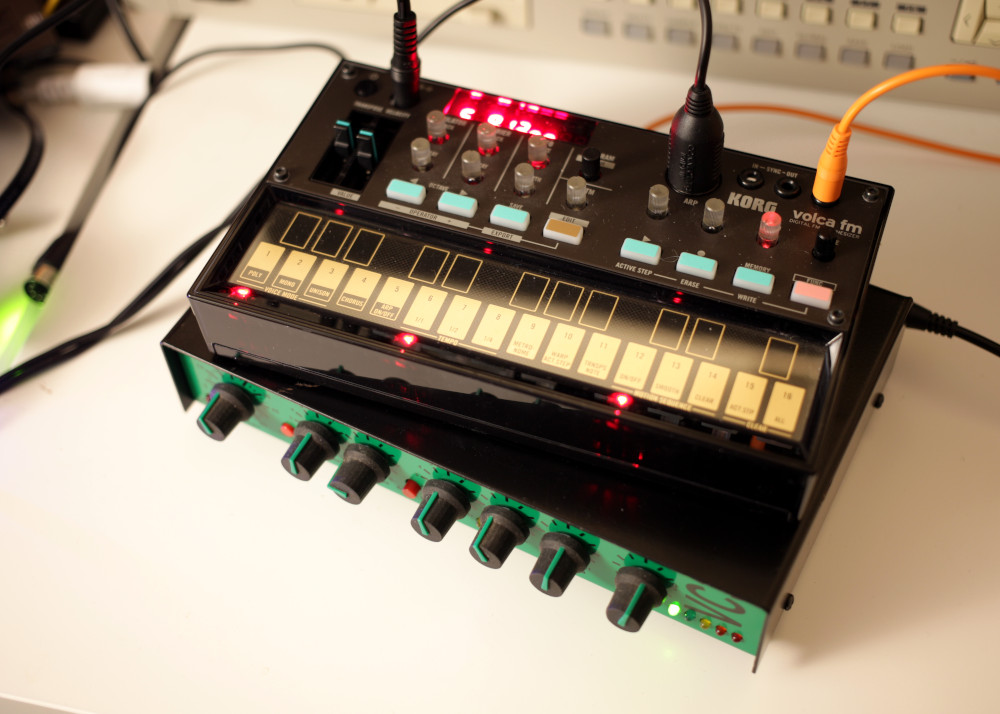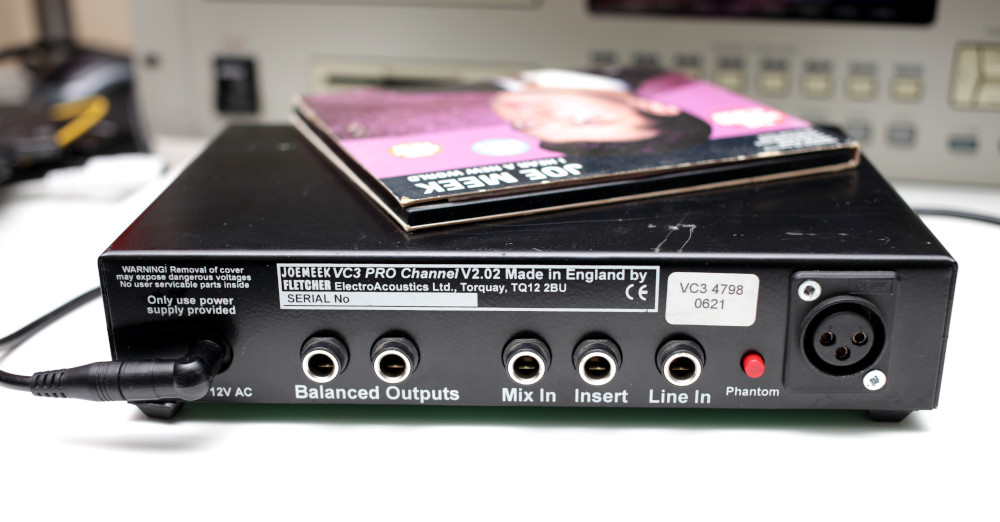Frumple. I like that word. Let's have a look at the Joe Meek VC3, a
handy little bit of studio gear from the mid-1990s. It's a combination
pre-amp, compressor, and exciter, intended to provide the functionality of a
mixing desk's voice channel in a smaller package. I bought it mostly for the compressor,
but it's a versatile box of tricks.
I'll give you an example of the simplest feature, the pre-amp. My old iPad has
some good software synthesisers, but the headphone output is low; in the photo
below I'm using the VC3's pre-amp to boost the iPad's volume before it goes
into my audio interface, which isn't something the VC3's designers could have
envisaged in 1996, but here we are:
At lower settings the VC3's pre-amp is essentially transparent. It synergises with
the compressor, the idea being that you can use the pre-amp to boost a signal
high enough to trigger the compressor, which fattens up the signal.
Incidentally this iM1, a recreation of the late-80s/early-90s Korg
M1 in software form. The M1 has aged in an interesting way. Back in 1989 musicians loved the excellent presets and the combination of a 16-bit stereo sound engine, built-in
multi-effects, and an eight-track sequencer. The sequencer could drive external gear via MIDI, so in theory you could use an M1 as the heart of a studio, instead of an Atari ST running Cubase or whatever. On the downside the M1 was weak as a means of creating new sounds. The synthesis engine was restricted to layering pre-recorded samples on top of each other. As with the Yamaha DX7 a few years earlier it sold to professional musicians who needed a ready source of good sounds, and there's nothing wrong with that, but more adventurous musicians were turned off by its homogenous sound.
The M1's chunk-a-chunk house piano and bloopity-bloop organ bassline were
plastered all over early-90s dance-pop, such as e.g. "Show me Love" by Robin S, or
"Push the Feeling On" by the Nightcrawlers. That kind of organ sound was the in thing circa 1992. If you had a sampler with a bunch of Roland TR909
samples and some outboard effects you could conceivably make an entire pop
track with a Korg M1, or at least a solid demo.
The M1's most famous sounds quickly became linked to a certain era, but some of the presets are genuinely timeless, despite being constructed from just 4mb of
sample memory. People remember the organ and piano but there are solid,
anonymous sounds that still sound good. Furthermore there's nothing wrong
with early-90s dance-pop, so as of 2022 the M1 is both a retro throwback to
the SNES era and also a
genuinely usable, playable instrument. Nowadays seems to hang around in recording
studios as the archetypal
synthesiser-for-bands-that-don't-have-their-own-synthesiser.
But what about Joe Meek? He was a British record producer of the late 1950s,
early 1960s, most famous for writing and recording "Telstar" by The
Tornados. He worked independently of EMI and Decca, recording
music in his bedroom studio with a stack of custom-made equipment, something
that was extremely rare in the 1960s. Between 1959 and 1964 he produced or
co-produced four number one singles, including the Tornados' "Telstar", the
Honeycombs' "Have I The Right", John Leyton's "Johnny Remember Me", plus a
clutch of songs that charted in the top forty.
With drums, especially a Behringer RD8 TR-808 clone. Mid-way through the video I use the pre-amp as a distortion effect, which makes the drum loop sound like something from Warp Records.
I have to admit I'm not familiar with Meek's work. He coexisted with
The Beatles for a while, but his music has largely been thrown onto the great big
scrapheap of pre-Beatles British pop, from back when the charts were
dominated by light entertainers who could sing and dance and tell jokes. The
modern stereotype of the pre-Beatles period is that the performers were miserable people who hated their job, hated being stuck in England, hated being pale imitations of the Americans, hated having to do
shows in tiny little towns for pennies, hated their singing partners, hated themselves.
Pumping - and distorting - a bassline.
Flicking through some of Meek's productions on YouTube I'm struck by their
aggressive, jangly, beaty quality, and also their trebliness - possibly an
artefact of YouTube - but at the same time even his later recordings seem
stuck in the pre-Beatles era, or at least "Please Please Me"-era Beatles. On a sonic level he had a yen for Pink Floyd-style experimentation, but his musical tastes seem stuck in the past.
The VC3 has balanced inputs and outputs. If you're plugging a guitar
into the line input you might want to run it through a DI box first. The first units were apparently assembled by hand; as far as I can tell the V2 version had some internal tweaks to facilitate mass-production but was otherwise the same as the original VC3.
About twenty years ago I picked up a reissue of I Hear a New World, a collection of psychedelic instrumentals written and produced by Meek in
the very early 1960s. Meek is an odd figure. The sci-fi
space stylings of his music should have fit in with the burgeoning
psychedelic scene, and in some respects New World feels like a
prototype of Syd Barrett-era Floyd, but there was something 1950s,
pre-psychedelic about his vision of outer space.
Unfortunately he become convinced that the major record labels were trying to
destroy him, and in the end he spiralled into drug-fuelled paranoia, driven
partially by a fear that gangsters and/or the police would use his
homosexuality to blackmail him. In a fit of anger in early 1967 he shot his
landlady to death and then turned the gun on himself. His latter-day cult fame
is tempered by the fact that he killed an innocent woman, so it's hard to
warm to the man, but there remains a great big what-if about him. What if he'd
tried dope instead? What if he didn't have to live in fear of the police?
Would he have just ended up producing Top of the Pops covers
records, or something more?
It strikes me that he would have been happier as an audio engineer. He wanted to be a music mogul along the lines of Phil Spector or Simon Cowell, but in interviews he doesn't come across as steely-nerved enough to manage pop acts. Unfortunately the idea of engineer-as-studio-star didn't exist back then - Alan Parsons and Bob Clearmountain were not yet household names - and I imagine you couldn't just rock up to Abbey Road studios and ask for a job, besides which it would in theory have been a step down for him. I'm waffling at this point. I'll move on.
Thirty years later, and seemingly apropos of nothing, Meek's former studio
assistant Ted Fletcher updated some of his studio designs and re-released
them. They sported fetching green paint, apparently a shade of British Leyland
green that happened to be available. Judging by
Sound on Sound's reviews from the period
the equipment sold well. The market for boutique
compressors was just taking off in the mid-1990s, and by all accounts the new
Joe Meek equipment was well-made and keenly-priced. Their range included were a couple of
compressors and a bunch of equalisers, as detailed by Fletcher's son in
this handy blog post here. The VC3's instrument manual mentions hard disk recording, at the time a new
technology; Fletcher seems to have envisaged the VC3 as a means of making digital
recordings sound more analogue.
In 2003 Fletcher sold the Joe Meek business to a US company that still sells Joe Meek gear. The modern heir of the VC3 is the Joe Meek ThreeQ, which was launched back in the mid-2000s. Fletcher himself makes a small range of compressors and signal processors under the TFPro name although he doesn't sell anything that precisely duplicates the VC3.
What's the VC3 like? I'll post some videos, but subjectively the pre-amp is
transparent. I tried recording some guitar with a DI box, and it was no more
or less noisy than the same setup fed through my audio interface with the gain
turned up. With a line-level signal the pre-amp can be made to distort,
although it's not an especially attractive distortion. The compressor is
strong enough to clamp down on the pre-amp, even when it's turned all the way up, but you have to be careful -
if you play a run of notes and then leave a pause, the next note after that
will be extra-loud.
As a volume limiter therefore the compressor can work even with really loud
signals, although at high levels the first split-second of the attack is distorted. At the most compressed
setting there's a definite pop-pop-pop aggression to the sound. At mild settings it's more or less transparent, and can be left
turned on at about the 75% position with a slow release, slow attack all the
time. With the pre-amp turned up and the compressor active the sound gets
thick and bassy.
The exciter adds distortion to the high frequencies. To my ears it makes the
signal sound fizzy, but it also amplifies the noise. With all the controls
turned up the end result sounds a lot like a noisy tape cassette with some
kind of treble boost, which is the effect I was going for with this tune:
Setting it up is easy, although you have to use the right power supply. At
first I tried a generic 12v PSU, but it didn't have enough juice, and
although the box turned on it didn't compress. After getting hold of the right
supply it worked fine. The VC3 has a pair of outputs, but it's not stereo. The two
outputs are the same, the idea being that you can use one for monitoring.
For
the following track I arranged everything with Logic, then fed the channels into the
VC3, with the compressor on full and the exciter about half-way:
I then fed everything through one of Logic's compressors, which had the
cumulative effect of boosting the bass and making the whole thing sound
slightly fuzzy and warbly, again as if it was played from an old cassette
tape.
And that's the VC3. At mild settings the pre-amp and compressor are transparent. When pushed the compressor enhances the bass and makes the mix sound more "full", but it's not as precise or "thwacky" as modern VCA-style compressors. It doesn't have a side chain input, so it's not much use for French disco. If you leave the compressor on all the time, with a mildly hot signal from the pre-amp, the result is a subtle warming effect.
The exciter makes everything sound like an old tape cassette tape, which is not necessarily a bad thing if you want a grainy, gritty effect. A few years later the VC3 was replaced by the VC3Q, which had a three-band equaliser - Ted Fletcher called it a Meequaliser - instead of the exciter. At that time the VC3Q would have been a better option, but you probably have EQ already, in which case the exciter is more fun.
NB the VC3 was specifically aimed at vocal recording, which has a much wider dynamic range than the mostly fixed-velocity synth lines I used. Vocalists and guitarists and flautists etc or people using microphones in general might have a different impression of it.






